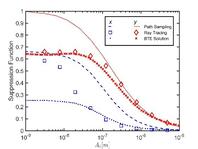Reevaluating the suppression function for phonon transport in nanostructures by Monte Carlo techniques
Reevaluating the suppression function for phonon transport in nanostructures by Monte Carlo techniques
| Event Date: | January 16, 2019 |
|---|---|
| Authors: | Y.Zeng and A. Marconnet |
| Journal: | Journal of Applied Physics |
| Paper URL: | Link to Full Text |
Thermal conductivity integral models including a suppression function to account for boundary scattering have had considerable success in explaining and predicting the thermal conductivity of nanostructures. However, the suppression function is analytically defined only for some simple structures, e.g., thin films and nanowires. For arbitrary nanostructures, Monte Carlo (MC) -based methods have been developed to calculate the suppression function. Here, we focus on two main types of MC-based methods: path sampling methods and ray tracing simulations. For the path sampling method, a more computationally efficient sampling algorithm is proposed based on the analytical solution of the average distance phonons can travel before a collision. The physical meaning of the path sampling method is rigorously given for the first time by comparing to the analytical solution of the Boltzmann Transport Equation for symmetric structures. Several limitations of the path sampling method are discussed based on assumptions in the derivation. Ray tracing simulations are well defined when a converged boundary mean free path (MFP) can be found. However, convergence is not guaranteed for arbitrary structures. More generally, we propose a modified formula to approximate the full-range suppression function with a characteristic length, which is determined by fitting to the calculated suppression function at selected MFPs. Ultimately the accuracy of each calculated suppression function is evaluated by comparing the calculated thermal conductivity accumulation function for nanostructures including thin films, nanowires, and anisotropic modulated nanostructures. Our results provide guidance for selecting the appropriate techniques for calculating the suppression function and predicting the thermal conductivity of nanostructures.

